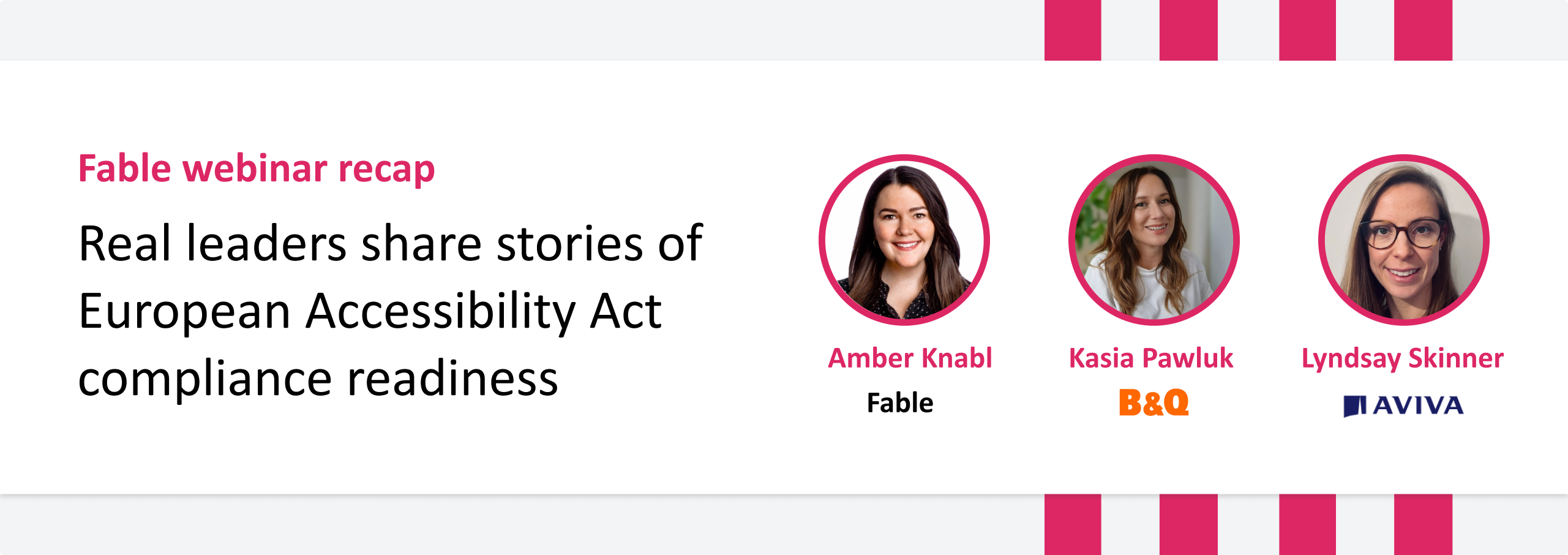
Real leaders share stories of European Accessibility Act compliance readiness
Regulations like the European Accessibility Act (EAA) set deadlines, but accessibility isn’t something teams finish and file away. Real readiness is measured in customer experiences, not calendar dates. And a recent Fable webinar revealed that many teams back confidence in their progress.
How today’s teams are tackling EAA
During the webinar, two product and design leaders – Lyndsay Skinner, Head of Digital at Aviva UK and Kasia Pawluk, UX researcher at B&Q – shared what EAA readiness looks like in their organizations. Keep reading to dig into their lived experiences with tackling the EAA and moving toward lasting accessibility maturity.
Watch Kasia Pawluk, UX researcher at B&Q, share how the European Accessibility Act became a catalyst for embedding accessibility requirements back into culture and workflows.
The EAA has clearly been a catalyst pushing accessibility requirements from “nice to fave” to a business priority.
Compliance gets attention
Compliance alone doesn’t lead to better usability for people with disabilities. But for many organizations, European Accessibility Act compliance is a lever that finally gets leadership attention and secures resources. Lyndsay Skinner explains.
“In Aviva, that compliance-driven piece is quite useful for us,” she says. “Aviva is very risk-aware and considers those sorts of things really important. So, actually, compliance isn’t necessarily a bad word when it comes to accessibility. It can kind of be a best friend in terms of getting people to listen and buy into it.”
Interestingly, Aviva isn’t directly subject to the EAA regulations. But Skinner describes a ripple effect.
“Our journey has been about laying out principles adjacent to the EAA rather than enforced by it,” she says. “We focus on ensuring that all new digital journeys we build meet WCAG standards. We’re definitely benefiting from the halo effect of the EAA—, with more focus on accessibility within the business.”
B&Q’s Kasia Pawluk agrees that compliance helps create urgency, but it doesn’t ensure inclusive experiences on its own.
“Compliance-driven testing and inclusive research with users of assistive tech… they play very different roles,” says Pawluk. “Some people think, ‘Oh, I can do just the testing, and then I don’t need the research.’ You need both of them. They go hand in hand at the end of the day.”
That’s why compliance is best seen as a starting point, not the finish line. It ensures you meet today’s standards, but sustainable accessibility is what delivers barrier-free digital experiences as the EAA’s harmonized standards continue to evolve.
“Automated checks will spot some issues, but to truly understand the customer’s experience, we run inclusive usability sessions with Fable. Those tests flag not only technical violations, but also blockers like confusing language or too many steps. Those things will never be caught in compliance-driven testing.”

Kasia Pawluk
UX Researcher, B&Q
“Automated checks will spot some issues, but to truly understand the customer’s experience, we run inclusive usability sessions with Fable. Those tests flag not only technical violations, but also blockers like confusing language or too many steps. Those things will never be caught in compliance-driven testing.”

Kasia Pawluk
UX Researcher, B&Q
Peer-tested strategies for sustainable accessibility
Here are six lessons Kasia and Lyndsay learned on their EAA readiness journeys:
1. Make accessibility a shared business priority
At B&Q, goodwill towards accessibility was the norm, but the team lacked a clear vision, consistent motivation, and roadmap to drive it forward.
“Through an internal survey we discovered that everyone thought accessibility was very important, and also everyone believed that this is someone else’s responsibility,” says Pawluk. “These responses were consistent across the hierarchy in the organization. Even leadership gave us the same answers.”
She credits the EAA as a critical turning point that provided the external driver needed to move accessibility requirements from a niche concern to a negotiated business priority at B&Q. That shift helped build internal buy-in and investment.
“Now it’s not optional anymore. We need to meet the regulations, and it gave us this urgency to position accessibility as part of the strategy within different teams,” says Pawluk.
Today at B&Q, accessibility is integrated into very early planning discussions across product and design. For the first time, accessibility is part of OKRs and team strategies. “That’s made a big difference, because they will prioritize the workload differently,” says Pawluk. “It doesn’t come from the bottom anymore. It’s coming from the top.”
2. Build empathy and awareness across teams
Showing is far more powerful than telling when it comes to building accessibility buy-in across the organization.
For B&Q, holding empathy labs was key. These labs allowed stakeholders, including senior leaders, to experience their website with assistive technologies. They saw pain points for people with disabilities firsthand. The labs also offered the opportunity for the team to present the business case for accessibility, highlighting market value and the Purple Pound, which refers to the spending power of disabled households.
“People need to feel what it’s like in someone else’s shoes,” says Pawluk. “We had gloves that imitate arthritis. So someone might think, ‘Oh, my aunt has arthritis. This is how she feels!’ It gave people more personal connections to accessibility.”
3. Involve people with disabilities early and often
User testing with people with disabilities isn’t a one-off activity. Bringing them in throughout the research, design, and build process shifts the conversation from “what’s broken?” to “what could we do better?”
“We are starting to involve people with disabilities, not only in testing, but also in discovery research. So I think that’s a big change in the way we approach it,” says Pawluk. “We are moving from reactive fixes to proactive inclusion.”
Pawluk gave an example of an issue that compliance checks never would have caught. After the customer checkout, a confirmation message read “order dispatched.” While technically compliant, users with learning difficulties found it confusing.
“We changed the message to read “order on its way,” she said. “Once you make the improvement for accessibility, you make an improvement for all.”
4. Operationalize accessibility across workflows and systems
Accessibility requirements must be embedded in workflows and supported by systems, not treated as a separate task. Here are some of the strategies our speakers shared:
Mandate pre-launch accessibility training
Require both manual and automated accessibility testing before launch. At B&Q, pre-launch testing has become non-negotiable. “It does slow down our launch speed at times, but it also gives us assurance that new products and features are compliant straight away,” says Pawluk.
Keep accessibility top of mind with personas
At Aviva, personas have become a practical way to carry accessibility into everyday product workflows.
A cross-functional group of accessibility champions partnered with Fable to interview customers, then used those insights to create personas to guide everyone. The personas were launched on Global Accessibility Awareness Day (GAAD) with supporting video clips, which boosted engagement and ongoing interest across the company.
“The personas have been useful for the entire development process,” says Skinner. “From a propositions owner who’s thinking about what our next motor insurance offering will look like to an underwriter and all the way through to the people doing the digital design, development or QA.”
Share usability test clips widely
Regularly distributing clips from usability testing, especially those featuring people with disabilities, helps build empathy and provides direct input into design and development decisions.
Prioritize fixes
Aviva developed a prioritization framework to guide conversations about which accessibility requirements must be addressed before launch, and which can be scheduled for later iterations. “Ideally, you’d fix absolutely everything, but that prioritization framework helps with having conversations around getting high-priority fixes done fast and mapping out when to address the medium- or low-priority ones.”
Look at components in context
Skinner says it’s important to make sure that every element of the design system is accessible. She shared how a compliant info icon became overwhelming when used 15 times in a single journey.
“Technically that one little component ticked every box and looked great. And then they put it in research,” she says. “This customer journey had about 15 i’s. and the user feedback that we got was – Yes, I can technically do that. But it was so overwhelming they would have just given up.”
B&Q also focuses on design systems with the help of parent company, the Kingfisher Group. Kingfisher recently hired accessibility specialists to oversee their design systems, ensuring that all components at every level are accessible from start. Pawluk anticipates this speeding up their accessibility work.
Build feedback mechanisms
The focus on accessibility doesn’t end at launch. Aviva’s accessibility page allows customers to report barriers and request support, with frontline staff trained to handle these issues.
“On aviva.co.uk, we have an accessibility page where you can report accessibility challenges or request support if you can’t access something in a way that you are trying to,” says Skinner.
5. Invest in training and continuous learning
If you’re going to make accessibility part of the organizational DNA, onboarding and ongoing training plays a critical role.
Pawluk credits training with raising awareness and sustaining momentum beyond the EAA deadline. “Awareness is something we need to constantly work on. We need accessibility to be second nature for every team—not just those who work on it every day.” she says.
Aviva has always had training about vulnerable customers that’s enforced by its regulator. Skinner says the team has managed to extend that training so everybody in the organization is getting introductory training into accessibility.
6. Celebrate wins and share progress
EAA regulations may motivate organizations to embrace accessibility requirements, but recognition keeps teams energized. While there is much work to do, Skinner and Pawluk say it’s critical to take the time to celebrate team wins, recognizing achievements and sharing external validation.
“We won a couple of awards which was such a big jump from where we were last year,” says Pawluk. “We now have this very positive case study of how much you can improve.”
Aviva white labels insurance for other well-known brands in the UK. After launching a new product, the feedback was fantastic. “It was the first time that I’d actually seen accessibility as core of the feedback,” says Skinner. “It was one of those ‘wow’ moments within accessibility, where there’s an external company who is looking at what we did and those processes that we’ve worked hard to fight for.”
The long game: accessibility as competitive differentiator
While the EAA deadline was the catalyst for change, both Pawluk and Skinner stressed that the real payoff comes when accessibility shifts from compliance activity to a driver of differentiation and customer trust.
“In e-commerce, confidence and independence are very important, and accessibility is an opportunity to win trust and loyalty from underserved customer segments. If someone with a disability can navigate our website easily, find product information or how-to guides without barriers, that’s a big competitive advantage,” says Pawluk.
She highlights the risk of neglecting accessibility: 75% of customers who can’t shop due to accessibility barriers will never return, even as 25% of the UK population identifies as disabled. “As a national retailer, it’s a no-brainer that you need to provide them with the best possible experience. That creates real competitive advantage over those who don’t,” she adds.
Skinner believes that innovation will come once the organization meets the standards they should be at. “Particularly within insurance and financial services, the benefits of inclusive design really will benefit everybody,” she says. “By just simplifying experiences and making them more inclusive, everybody benefits. And that can only be good for business.”

